Hold onto your hats, folks, because we’re about to dive into a literary masterpiece that’s as complex as it is captivating: Fyodor Dostoevsky’s “The Brothers Karamazov.” This Russian novel isn’t just a story – it’s a philosophical roller coaster ride that explores the deepest corners of human nature, wrestling with faith, doubt, and the age-old struggle between good and evil.
Think of it as the “Game of Thrones” of 19th-century literature, but instead of dragons, you’ve got existential crises, and instead of Westeros, you’ve got the Russian countryside.
Get ready to meet the Karamazov brothers: Alyosha, the devout monk; Dmitri, the passionate and impulsive one; and Ivan, the intellectual skeptic who’s got a knack for stirring up trouble. Their father, Fyodor, is a total wildcard – a self-centered, scandalous dude who’s got a talent for driving his sons to the brink.
Together, they’ll take you on a journey that explores the depths of human emotion, the complexities of family relationships, and the ultimate question: What does it mean to be human?
The Philosophical and Religious Themes of The Brothers Karamazov
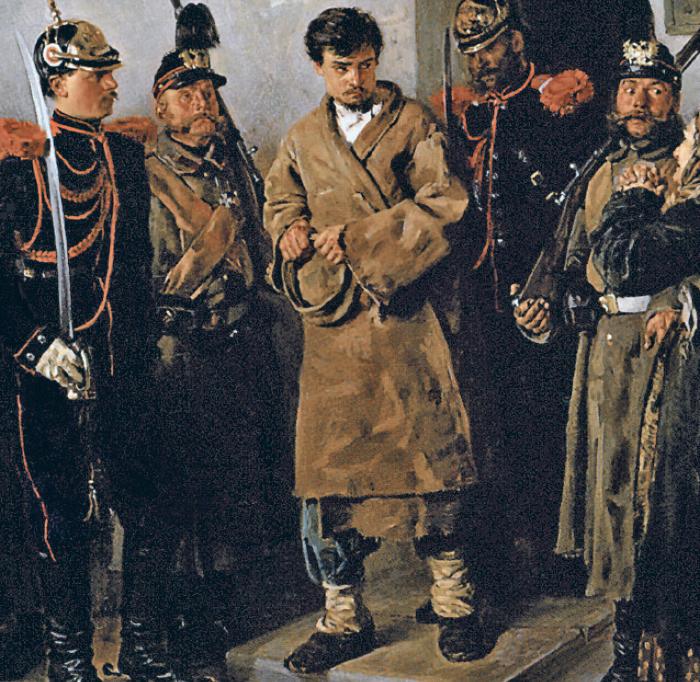
Dostoevsky’s own religious beliefs deeply influenced the novel’s exploration of faith, doubt, and free will. He was a deeply religious man who struggled with faith and doubt throughout his life, and these struggles are reflected in the characters and themes of The Brothers Karamazov.
The novel is a profound meditation on the nature of good and evil, the meaning of life, and the role of faith in a world where suffering and injustice abound. It presents a complex and nuanced exploration of these themes, offering no easy answers but instead inviting readers to grapple with these questions for themselves.
The Contrasting Perspectives of the Brothers
The three brothers, Alyosha, Dmitri, and Ivan, represent different approaches to faith, doubt, and free will. Alyosha, the youngest brother, is a devout monk who embraces faith and seeks to live a life of virtue. He represents the traditional Christian perspective, believing in God’s love and forgiveness.
Dmitri, the eldest brother, is a passionate and impulsive man who struggles with his own desires and often makes bad choices. He represents the temptation of earthly pleasures and the dangers of giving in to passion. Ivan, the middle brother, is an intellectual and a skeptic who rejects traditional faith and embraces nihilism.
He represents the questioning of faith and the struggle to reconcile belief with the realities of suffering and injustice.
The “Grand Inquisitor” Parable
The “Grand Inquisitor” parable is one of the most famous and controversial passages in The Brothers Karamazov. In this parable, Ivan imagines a future where Christ returns to Earth and is promptly imprisoned by the Grand Inquisitor, a powerful church leader who believes that humanity is too weak and sinful to handle true freedom.
The Grand Inquisitor argues that the church has done humanity a service by offering them a system of rules and beliefs that provide them with security and comfort, even if it means sacrificing true freedom. This parable raises profound questions about the nature of faith and the relationship between God and humanity.
It suggests that faith can be a source of both comfort and oppression, and that the pursuit of true freedom may come at a great cost.
Nihilism and Existentialism
Nihilism and existentialism are two key philosophical concepts that are explored in The Brothers Karamazov. Nihilism is the belief that life is meaningless and that there is no inherent purpose or value. Ivan embraces this philosophy, arguing that if God does not exist, then everything is permissible.
Existentialism, on the other hand, emphasizes the freedom and responsibility of individuals to create their own meaning and values. The novel suggests that both nihilism and existentialism can be dangerous if taken to extremes, but that they also offer valuable insights into the human condition.
The Nature of Good and Evil
The Brothers Karamazov explores the nature of good and evil in a profound and challenging way. The novel suggests that good and evil are not simply abstract concepts, but rather forces that are constantly at work within each individual. The brothers themselves are all capable of both good and evil, and their struggles reflect the internal conflict that exists within all of us.
The novel also suggests that the line between good and evil can be blurred, and that even the most virtuous individuals can be tempted to do wrong.
The Complex Characters and Their Relationships
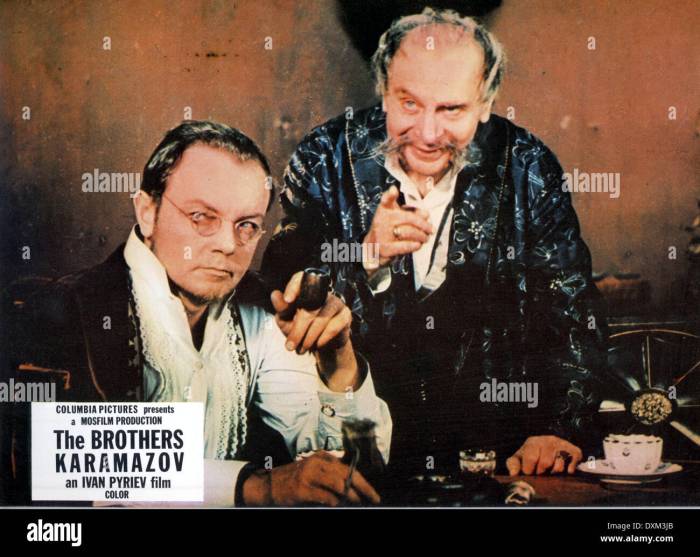
The Brothers Karamazov is a novel filled with characters that are more than just names on a page. They are complex individuals with intricate relationships, each driven by their own desires and motivations. This web of interconnectedness fuels the drama, conflict, and ultimately, the philosophical exploration that defines the novel.
Fyodor Karamazov: The Patriarch of Chaos
Fyodor Karamazov, the patriarch of the Karamazov family, is a man of immense contradictions. He is a figure of both fascination and disgust, a man who embodies the dark side of human nature. Fyodor is a dissolute, self-absorbed, and deeply flawed individual.
He is a man of appetites, driven by lust, greed, and a desire for power. He is also a master manipulator, using his charm and cunning to control and exploit those around him. Fyodor’s influence on his sons is profound and deeply damaging.
He instills in them a sense of resentment, fear, and a longing for something more than the chaotic and dysfunctional life he has created. He is a walking contradiction, a man who is both repulsive and strangely compelling. His presence casts a long shadow over the lives of his sons, shaping their destinies and driving them towards their own unique paths.
The Sons of Fyodor: Alyosha, Dmitri, and Ivan
- Alyosha, the youngest son, is a devout monk who embodies faith and compassion. He is drawn to the spiritual path and seeks solace in the teachings of his mentor, Elder Zosima. Alyosha is a gentle and forgiving soul, representing the potential for goodness and redemption.
He is a stark contrast to his brothers, offering a different path and a different vision of the world. He is the voice of reason and morality, urging his brothers to choose a path of righteousness and compassion.
- Dmitri, the eldest son, is a passionate and impulsive man. He is driven by his desires, especially for Grushenka, a woman who embodies both beauty and danger. Dmitri is a man of action, prone to rash decisions and violent outbursts.
He is caught in a web of his own making, struggling with his desires and his sense of duty. He is a symbol of the destructive power of passion, often acting on his emotions without considering the consequences.
- Ivan, the intellectual son, is a man of reason and skepticism. He rejects traditional religious beliefs and embraces a more rational and nihilistic worldview. Ivan is a brilliant but tormented soul, struggling with the complexities of life and death. He is the voice of doubt and despair, questioning the existence of God and the meaning of life.
His intellectual pursuits lead him to a profound existential crisis, culminating in his famous “rebellion” against the world and his ultimate downfall.
Smerdyakov: The Shadow of the Family
Smerdyakov, the illegitimate son of Fyodor, is a complex and unsettling character. He is a man of intelligence and cunning, but also deeply troubled and consumed by resentment. He is a product of Fyodor’s neglect and abuse, harboring a deep-seated hatred for his father and the entire Karamazov family.
Smerdyakov’s connection to the family’s internal struggles is undeniable. He is a catalyst for conflict, his actions ultimately leading to the murder of Fyodor. He represents the dark side of the family’s legacy, a symbol of the destructive consequences of their dysfunctional relationships.
The Significance of the Female Characters
- Grushenkais a captivating and enigmatic figure who embodies both beauty and danger. She is a woman of passion and independence, a source of both attraction and destruction for the Karamazov brothers. Grushenka represents the seductive power of the world, the allure of pleasure and the potential for chaos.
- Katerina Ivanovna, Dmitri’s former fiancée, is a woman of fierce pride and loyalty. She is a symbol of the destructive power of jealousy and obsession. Her love for Dmitri is all-consuming, leading her to acts of desperation and revenge. She represents the darker side of human emotion, the capacity for both love and hatred.
- Lizaveta, the innocent and kind-hearted sister of Katerina Ivanovna, is a victim of the Karamazov family’s turmoil. She is a symbol of vulnerability and innocence, a reminder of the human cost of the family’s destructive actions. Her tragic death highlights the consequences of the family’s internal struggles.
The Novel’s Narrative Structure and Style
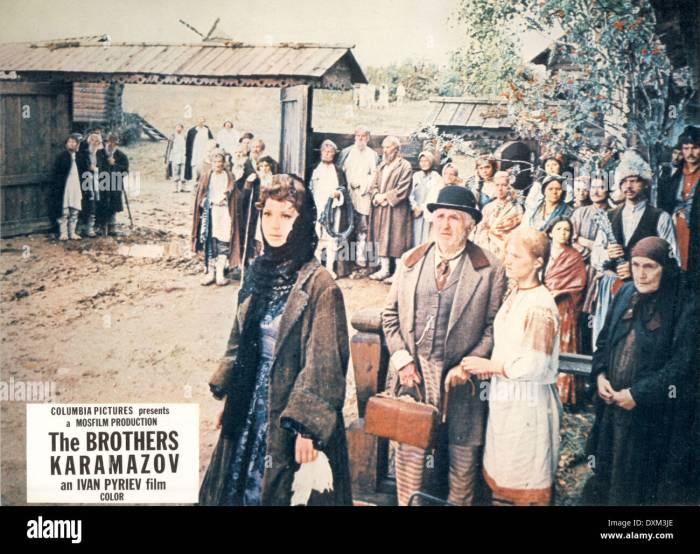
Dostoevsky’s _The Brothers Karamazov_ is a sprawling masterpiece of psychological realism, characterized by its intricate narrative structure and immersive style. The novel’s brilliance lies in its ability to delve deep into the human psyche, exploring the complexities of faith, morality, and human relationships through a multifaceted and dynamic approach.
Multiple Perspectives and Interwoven Storylines
Dostoevsky masterfully employs multiple perspectives and interwoven storylines to create a rich and complex narrative tapestry. The novel is narrated from the perspectives of various characters, each offering their unique insights and interpretations of events. This technique allows the reader to experience the story from multiple angles, gaining a deeper understanding of the characters’ motivations and the intricate web of relationships that bind them.
For example, the story is told through the eyes of Alyosha, the devout and compassionate brother; Dmitri, the passionate and impulsive brother; and Ivan, the intellectual and skeptical brother. Each brother’s perspective provides a distinct understanding of the family’s dynamics, their personal struggles, and the broader philosophical questions that underpin the novel.
Dream Sequences, Flashbacks, and Inner Monologues
Dostoevsky’s use of dream sequences, flashbacks, and inner monologues allows him to delve into the characters’ psyches and motivations, revealing their deepest desires, fears, and anxieties. The dream sequences, often surreal and symbolic, offer glimpses into the characters’ subconscious minds, revealing their hidden thoughts and repressed emotions.
Flashbacks provide context and backstory, illuminating the characters’ past experiences and shaping their present actions. Inner monologues, particularly those of Ivan and Smerdyakov, offer profound insights into their intellectual and moral struggles, revealing their philosophical and existential dilemmas. These techniques create a deeply immersive reading experience, allowing the reader to journey alongside the characters through their inner landscapes.
Setting and Its Influence
The setting of _The Brothers Karamazov_, primarily the Russian countryside, plays a significant role in shaping the characters’ lives and relationships. The stark beauty and vastness of the landscape reflect the characters’ own internal struggles and the complexities of their moral choices.
The idyllic setting of the monastery, where Alyosha finds solace and spiritual guidance, contrasts sharply with the tumultuous world of the Karamazov brothers, highlighting the tension between faith and doubt, spirituality and worldly desires. The influence of the setting is further amplified by the novel’s exploration of the Russian peasantry, their beliefs, and their impact on the lives of the characters.
Symbolism and Imagery
Dostoevsky masterfully employs symbolism and imagery throughout the novel, enriching its themes and adding layers of meaning. The recurring image of the “Grand Inquisitor” in Ivan’s dream sequence symbolizes the seductive power of authority and the potential for faith to be corrupted by human ambition.
The motif of the “lost paradise” in the story of the “Legend of the Grand Inquisitor” reflects the characters’ yearning for spiritual fulfillment and their struggle to reconcile faith with the realities of human suffering. The use of light and darkness, fire and water, further enhances the novel’s symbolic language, illuminating the characters’ moral choices and the complex interplay of good and evil.
Book Review of The Brothers Karamazov
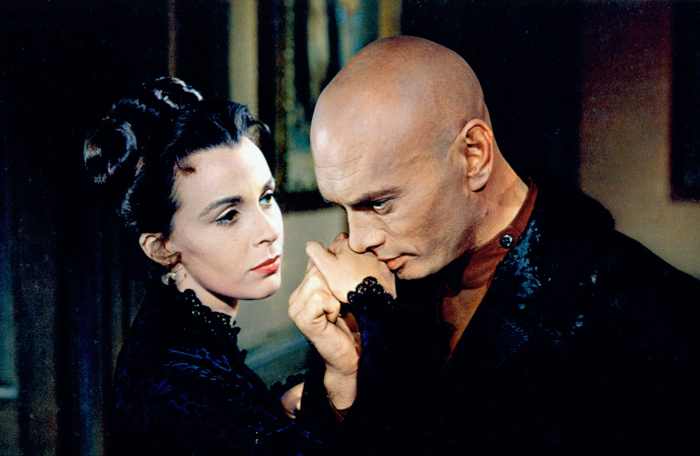
The Brothers Karamazov is a novel that is as much a philosophical treatise as it is a literary masterpiece. It’s a story that delves into the depths of human nature, exploring themes of faith, morality, and the nature of good and evil.
Dostoevsky masterfully weaves together a complex narrative with compelling characters, creating a timeless work of art that continues to resonate with readers today.
The Novel’s Plot and Setting
The story centers around the Karamazov family, a dysfunctional group of individuals whose lives are intertwined with a web of secrets, betrayals, and moral dilemmas. The patriarch, Fyodor Karamazov, is a wealthy landowner who is known for his debauchery and lack of morals.
He has three sons: Dmitry, a hot-headed and impulsive man; Ivan, a brilliant but cynical intellectual; and Alyosha, a devout and compassionate young monk. The novel unfolds against the backdrop of 19th-century Russia, a society grappling with rapid social and political changes.
The setting plays a crucial role in shaping the characters’ beliefs and actions, as they navigate a world torn between tradition and modernity.
The Novel’s Main Characters
Each of the Karamazov brothers represents a different facet of human nature. Dmitry, driven by his passions, embodies the destructive force of unchecked desires. Ivan, with his sharp intellect and cynical worldview, embodies the allure of nihilism and the rejection of traditional morality.
Alyosha, the embodiment of faith and compassion, offers a counterpoint to his brothers’ struggles, representing the possibility of redemption and spiritual growth. The novel’s supporting characters, including the enigmatic Smerdyakov and the wise Elder Zosima, further enrich the tapestry of human experience that Dostoevsky presents.
Personal Thoughts and Interpretations
The Brothers Karamazov is a novel that challenges readers to confront their own beliefs and values. Dostoevsky’s masterful use of dialogue and internal monologues allows us to delve into the minds of his characters, witnessing their internal struggles and moral dilemmas.
The novel’s exploration of faith and doubt, free will and determinism, and the nature of good and evil is both thought-provoking and unsettling.
The Novel’s Strengths and Weaknesses
The Brothers Karamazov is a literary tour de force, showcasing Dostoevsky’s unparalleled ability to create complex and compelling characters, weave intricate plots, and explore profound philosophical themes. The novel’s strength lies in its ability to engage readers on multiple levels, both intellectually and emotionally.
However, the novel’s length and complexity can be daunting for some readers. The intricate web of relationships and the philosophical discussions can be challenging to follow at times.
Recommendation
The Brothers Karamazov is a novel that demands time, effort, and an open mind. It is not a light read, but it is a rewarding one. If you are willing to engage with its complex themes and characters, you will be rewarded with a literary experience that will stay with you long after you finish the last page.
Last Recap
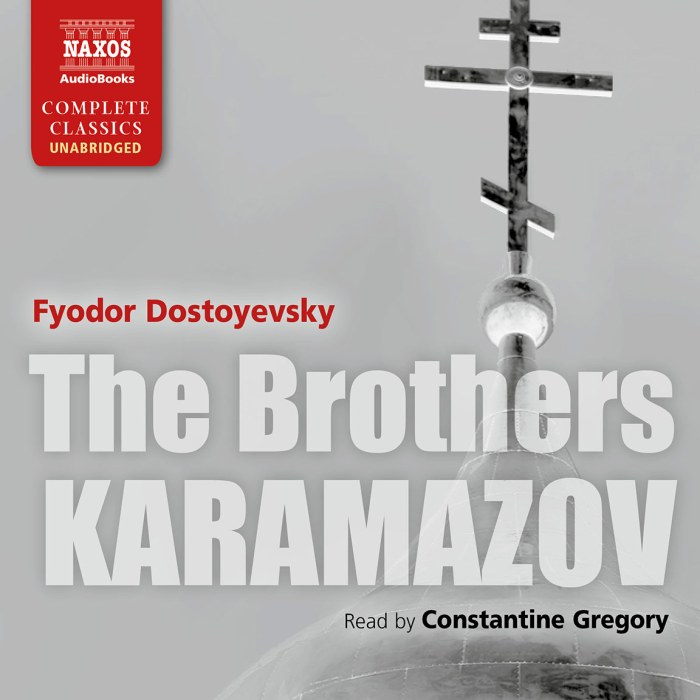
So, there you have it – a glimpse into the epic world of “The Brothers Karamazov.” It’s a novel that will stay with you long after you turn the final page, leaving you with more questions than answers. It’s a story that challenges your beliefs, forces you to confront your own morality, and ultimately reminds you that life, with all its complexities and contradictions, is a beautiful and fascinating thing.
So, if you’re looking for a book that will make you think, feel, and maybe even question everything you thought you knew, “The Brothers Karamazov” is your jam.
Detailed FAQs
Is “The Brothers Karamazov” really that long?
Yep, it’s a hefty read, clocking in at over 800 pages. But trust me, it’s worth the time investment. It’s like a literary marathon, but with a finish line that’s totally worth the effort.
What’s the deal with the “Grand Inquisitor” parable?
It’s a mind-blowing story within the novel, where Ivan imagines Jesus returning to Earth and being arrested by the Grand Inquisitor, who claims to be acting in the best interests of humanity. It’s a powerful exploration of free will, faith, and the nature of power.
Is it okay to read “The Brothers Karamazov” without any background in philosophy?
Absolutely! You don’t need a PhD in existentialism to enjoy this book. It’s a story that speaks to the human condition on a fundamental level, even if you’re not familiar with the philosophical jargon.

